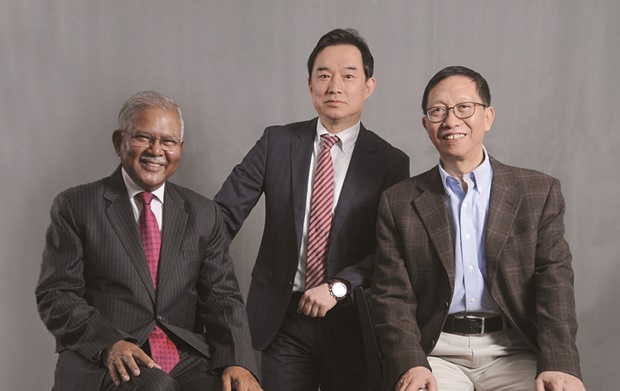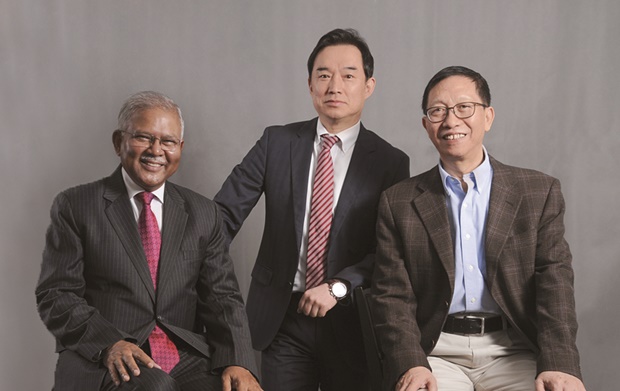Climate of Challenges
Survival In New Trade War: Broad Exports, No Taking Sides

Source:Ming-Tang Huang
The United States and China are jabbing and parrying at each other in the start of a “new Cold War” that shows no signs of abating over the short term. Meanwhile, regardless of how future negotiations turn out, competition between the two powers will surely set the tone going forward. Given this environment, how can Asian nations find ways to survive and thrive?
Views
Survival In New Trade War: Broad Exports, No Taking Sides
By Shu-ren KooFrom CommonWealth Magazine (vol. 666 )
With 2018 as a watermark, Sino-American relations have entered a new era of all-out competition. As tensions have grown, the term “Cold War”, dormant for nearly 30 years since the collapse of the Soviet Union, is back on people’s lips.
With trade being the fuse, this new tension spans such aspects as competing systems, policies, corporations, technology, military, international organizations, and regional politics. U.S. President Donald J. Trump is not guaranteed a second term in 2020, and the trade war could thus reach a ceasefire. However, by the same token, the new competitive environment could endure for the foreseeable future.
The emergence of new competition has shaken up the international economic and political order headed up by the United States like never before in the 70 years since World War Two.
Responding to the new international political and economic order will surely be the greatest challenge for governments and corporations around the world over the course of 2019.
No Easing of Tensions on The Horizon
On the surface, the main cause of the new cold war was U.S. demands that China adjust various policies featured under China’s party-run authoritarian capitalist system, such as subsidies to state enterprises, intellectual property infringement, theft of American technology, and inequitable treatment of foreign-invested enterprises in China.
However, the truth is that China’s rapidly growing power and influence is what has truly put fear in the United States over its continued dominance.
From the size of its economy to the might of its corporations, technology, and military, China is catching up to the U.S. at an alarming rate. And China’s coming into its own on the international stage and direct competition with the United States has only widened the gap with U.S. interests.
“The trade war is just a vehicle. The truth is that the existing dominant power wants to keep from losing its position to a rising dominant power,” said Ashok K. Kantha, former Indian Ambassador to China and currently Director of the Institute of Chinese Studies in Delhi, at the recent 2019 CommonWealth Economic Forum in Taipei. (Read: With China, Stay Engaged… and Alert)
Another aspect of the heating up of Sino-American competition is that the Western-led international economic and political order is coming apart.
The “America first” Trump administration’s position is that the international organizations and multilateral agreements wholly forged by the United States in the seven-decade post-war period are not only incapable of preserving the windfalls of the country’s dominance, but are unable to hold off the challenges posed by a rising China.
This has led the Trump administration to adopt the policy of “salvaging its hegemony” by engaging in bilateral negotiations in the effort to derive greater benefits.
Sogang University Professor Yoon Heo is a former member of Korea’s National Economic Advisory Council and a frequent participant in Korea’s trade policy formulation. He categorizes the international political-economic model as having shifted from one that stresses peace through trade and rule-based multilateral relations, to one under which trade advances national security through power-based bilateralism.
 From left to right, Ashok K. Kantha, Korea Sogang University Professor Yoon Heo, and Cheung Kong business school Professor Xu Chenggang, speaking at the 2019 CommonWealth Economic Forum (photo by Ming-tang Huang)
From left to right, Ashok K. Kantha, Korea Sogang University Professor Yoon Heo, and Cheung Kong business school Professor Xu Chenggang, speaking at the 2019 CommonWealth Economic Forum (photo by Ming-tang Huang)
How the Sino-American trade war and new cold war continue to unfold will ultimately be determined by the respective political and economic conditions within both countries.
Kantha believes that the U.S. and China should be able to reach an agreement before long, because “China has already sent the Trump administration a clear message: China has no intentions of replacing U.S. hegemony, and is willing to demonstrate flexibility on trade and economic issues,” he related.
As the U.S. begins to experience an economic reversal, if Trump wins reelection in 2020 he must ensure that the trade war does not come back to bite him. This would help smooth the way to having a good second term and would allow him to declare victory in the trade war.
Nevertheless, “even if a trade agreement is reached, it will have little effect on the fundamental state of competition,” opined Kantha. “As the old order recedes, the new order has not yet completely taken shape. So what happens next? That’s still hard to tell at the moment,” he emphasized.
No matter the outcome of U.S.-China competition, the entire globe should brace itself for the clash between the world’s two biggest economies. Southeast Asian countries, for whom regional politics and the industrial supply chain are inseparable from the U.S. and China, must be especially aware of the inherent risks of taking sides.
The U.S.’s call to arms in the trade war has reverberated throughout the global supply chain established by Taiwanese businesses over the past two decades between the United States and China, triggering the largest supply chain relocation in recent years.
Player 1: Korea
Spreading out Markets, Considering CPTPP Membership
Bowing under significant U.S. pressure, traditional American ally Korea returned to the negotiating table to revise the two countries’ bilateral free trade agreement, making considerable concessions ”especially in regard to restrictions on the volume of Korean steel export. I think this sets a bad precedent,” offers Yoon Heo.
Yoon Heo relates that the Korean government’s policy over the short term is to look for ways to spread out export markets rather than relying heavily on the American and Chinese markets. Meanwhile, the Korean Congress is working with other countries to return to multilateralism, while considering a bid to join the CPTPP (Comprehensive and Progressive Agreement for Trans-Pacific Partnership), among various measures.
“China used to frown upon Korea joining the Trans-Pacific Partnership led by the USA, so it opted to sign a free trade agreement with China first.” Now that the CPTPP does not include the U.S., membership would be more advantageous for Korea. I also recommend that Taiwan join it,” said Yoon.
Over the long term, Korea aims to continue enhancing the competitiveness of domestic corporations, while shifting industry’s center of gravity from manufacturing to services. (Read: AIT Chairman James F. Moriarty: Those who Play by the Rules will be our Partners)
Player 2: India
Maintain Neutrality, Rely on No One
For India, which has not been directly impacted by the trade war, the country must make every effort to remain neutral and not choose sides.
“People don’t like the United States pressuring everyone to take sides,” says Kantha. Regardless of Trump’s proposed “free and open Indo-Pacific strategy” India does not need to join in, as India’s interests differ from those of the U.S.
In Sino-Indo relations, although bilateral ties have improved due to rising tensions between the U.S. and China, “that’s because China needs friends as it faces difficulty, so that’s short-term, tactical,” relates Kantha. Nevertheless, “we haven’t seen evidence of China’s willingness to address the fundamental conflicts between China and India,” he adds.
Not just neighboring countries, but even principle player China must stay on its toes against frequent American offensives to keep the external pressure from the trade war from damaging China’s own economy.
Player 3: China
Only Reform Can End the Conflict
Cheung Kong business school Professor Xu Chenggang, who holds a Doctorate in economics from Harvard University, believes that China must change the system in order to resolve such long-term structural problems as low state-run enterprise efficiency as well as debt. However, changing the system would not only touch upon massive vested interests, but would threaten the foundation of Chinese Communist Party rule, complicating matters that much further. (Read: Challenges and Opportunities of Manufacturing in Vietnam)
Given this, “The external pressure resulting from the Sino-American trade war could potentially trigger domestic reform” (within China), offers Xu Chenggang. Many of the demands made by the U.S. during negotiations with China were consistent with the positions of those advocating reform inside China, such as intellectual property rights protection and further opening of the domestic market to foreign investment.
If China merely pays lip service to the United States in negotiations and fails to institute true reform, not only will the ceasefire in the trade war be merely temporary, but it will limit the further growth of the Chinese economy.
Contributors: Amber Lin, Yang Meng-hsua
Translated by David Toman
Edited by Sharon Tseng







